Master the 12 Types of French Pronouns
Go through the different types of French pronouns and learn how to use them correctly.
I want to learn...
In English, we use pronouns in everyday conversation or writing in order to replace nouns – the same goes for French pronouns. This helps improve the flow of conversations, as well as to provide more information about who or what we are referring to.
In French, there are 12 types of pronouns, meaning that there’s more for you to learn than in English. Learning all the French pronouns of the 12 types at once might seem a little daunting, but of course, practice is key here. We suggest coming back to this guide whenever you need to familiarize yourself with anything you’ve forgotten, or if you ever feel like you’ve not been using French pronouns as fluently as you’d like.
Using French pronouns will greatly aid your fluency, as it means that you’ll be able to swap nouns in conversation or writing for pronouns when it’s appropriate — adding some variation and flair, and helping you sound closer to a native speaker.
So, let’s get started on learning those 12 types of French pronouns and their uses!
When you’ll be using French pronouns
Instead of referring to something by its noun (or name) repeatedly, you can use pronouns that will help you avoid repetition. In French, there are many contexts in which it’s completely appropriate to do this!
Differences between English pronouns and pronouns in French
Before we get started on the different French pronoun types, let’s look at some key differences between English and French pronouns so that you know what mistakes to avoid.
Firstly, unlike English pronouns, all French pronouns have a gender. As each noun in French has a gender, you’ll need to make sure that when you replace it with a pronoun, that the pronoun’s gender matches that of the noun’s. This means that you’ll have to remember what gender a noun is each time you learn it, so you can use pronouns correctly.
While in English, you’ll often use the pronoun “it”, there’s not a true equivalent in French. The closest you’ll get is il, which means “he”. It is often used in similar cases to “it”, as masculine is the default gendered pronoun in French.
French pronouns will give you a lot more information about the noun that they’re replacing than English pronouns. Find this interesting? Great! We’ll look at this in more details below with our section on the 12 French pronouns.
The 12 types of French pronouns
Here are the 12 types of French pronouns that you’ll have to remember:
- Subject (or personal) pronouns
- Stress pronouns
- Direct object pronouns
- Indirect object pronouns
- Reflexive pronouns
- Relative pronouns
- Interrogative pronouns
- Indefinite pronouns
- Possessive pronouns
- Demonstrative pronouns
- The adverbial pronoun en
- The pronoun y
Let’s start with subject pronouns, before working our way through the rest of this list.
Subject pronouns
Subject pronouns replace a subject in a sentence, rather than an object. Below is a table with all of the French subject pronouns you need to know:
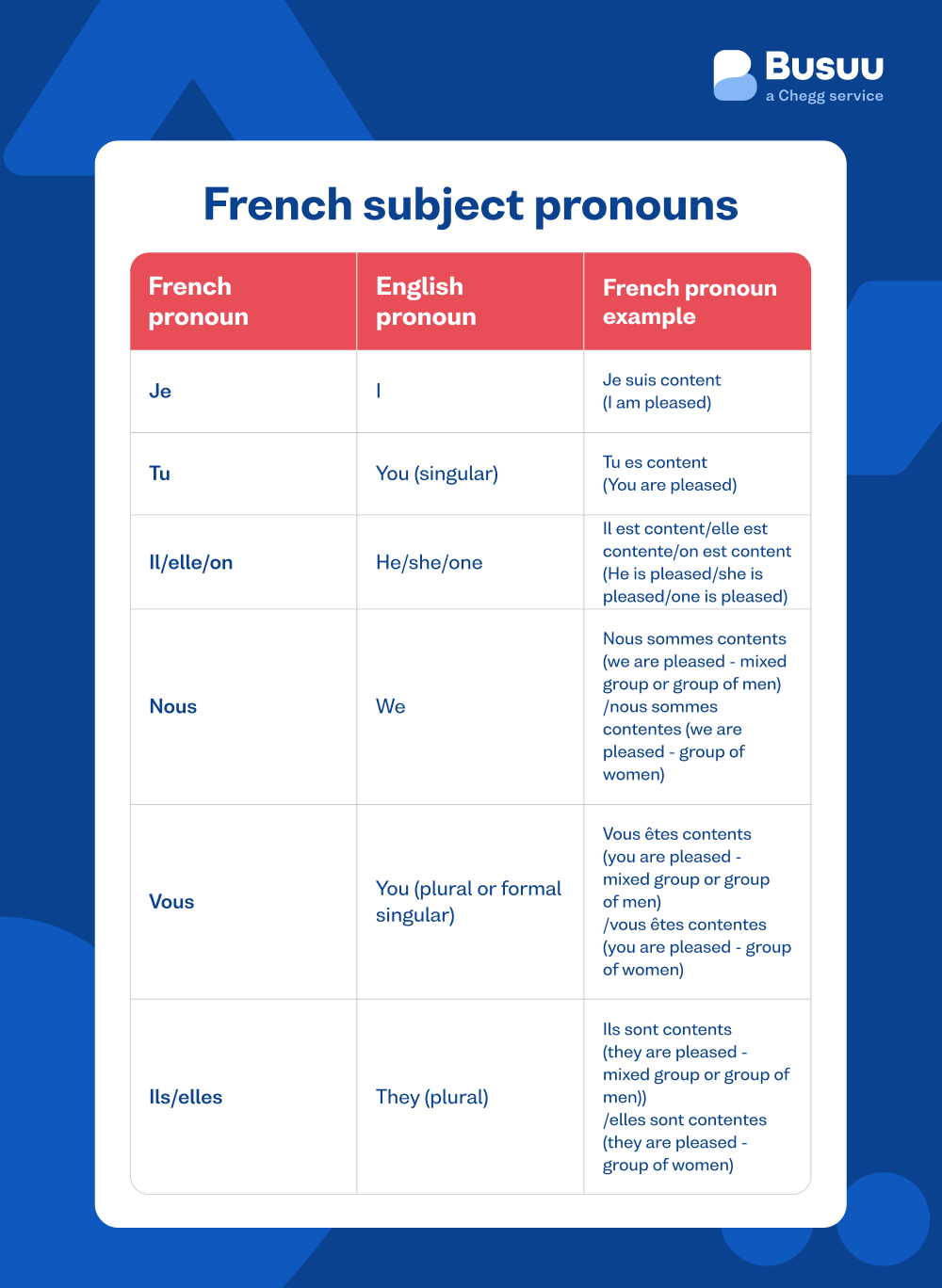
French subject pronouns table
| French pronoun | English pronoun | French pronoun example in a sentence with translation |
|---|---|---|
| Je | I | Je suis content (I am pleased) |
| Tu | You (singular) | Tu es content (You are pleased |
| Il/elle/on | He/she/one | Il est content/elle est contente/on est content (He is pleased/she is pleased/one is pleased) |
| Nous | We | Nous sommes contents (we are pleased - mixed group or group of men)/nous sommes contentes (we are pleased - group of women) |
| Vous | You (plural or formal singular) | Vous êtes contents (you are pleased. - mixed group or group of men)/vous êtes contentes (you are pleased - group of women) |
| Ils/elles | They (plural) | Ils sont contents (they are pleased - mixed group or group of men))/elles sont contentes (they are pleased - group of women) |
As you can see from our examples above, pronouns are also a crucial part of French conjugation. Unlike in English, using a personal pronoun changes the spelling of both the verb and the adjective in a sentence.
Stress pronouns
Let’s have a look at stress pronouns, or pronoms toniques. Remember, people tend to use on instead of nous in spoken French, so they have the same stressed pronouns here.
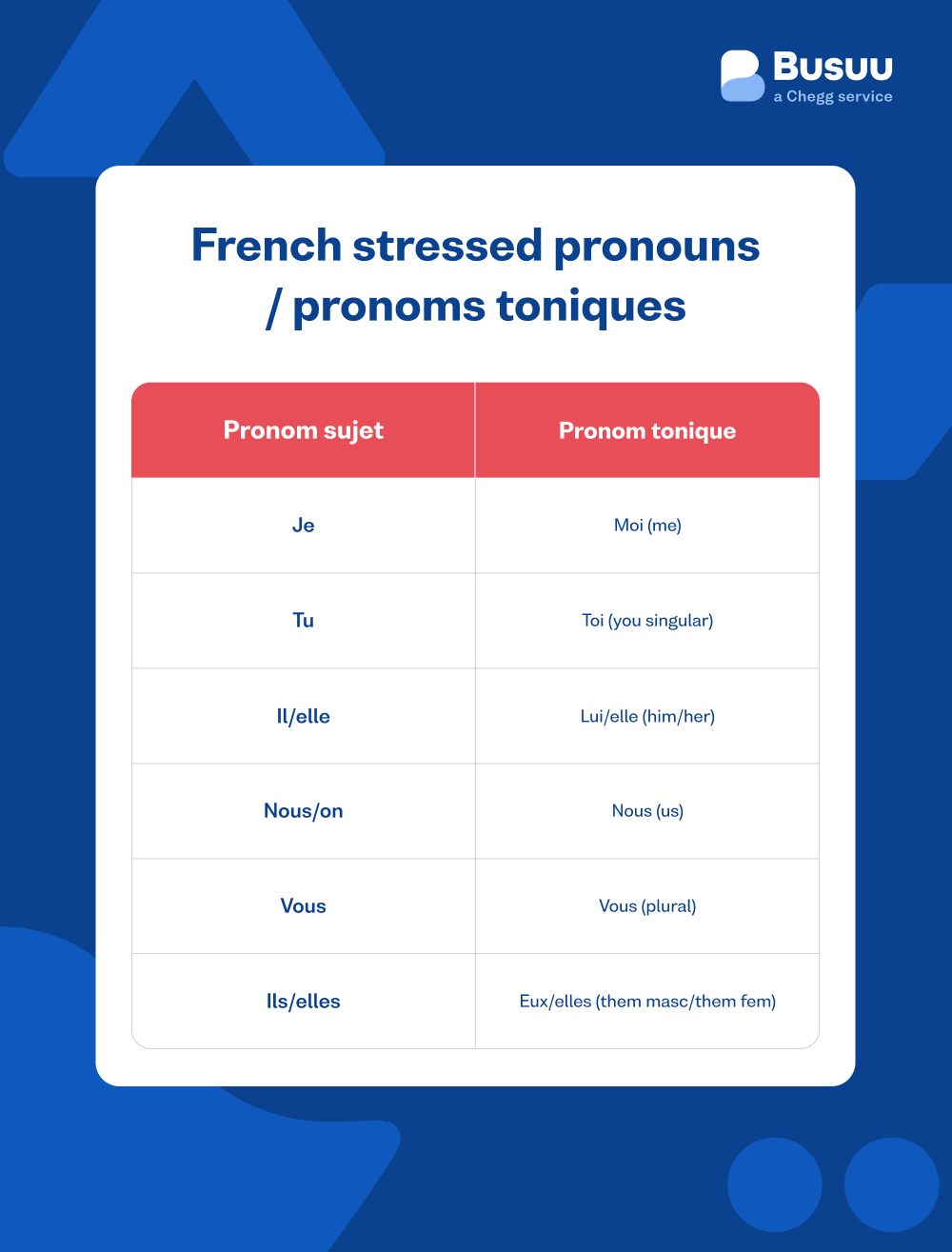
French stressed pronouns / pronoms toniques
| Pronom sujet | Pronom tonique |
|---|---|
| Je | Moi (me) |
| Tu | Toi (you singular) |
| ll/elle | Lui/elle (him/her) |
| Nous/on | Nous (us) |
| Vous | Vous (plural) |
| Ils/elles | Eux/elles (them masc/them fem) |
So, when do we use pronoms toniques? As we’ve just seen, one way we use them is to emphasize and reinforce a subject pronoun.
Have a look at the mini dialogue below to understand this:
- Sandra: Vous avez des personnalités similaires ? (Do you have similar personalities?)
- Benjamin: Non, moi, je suis assez timide mais lui, il adore sortir avec ses amis. (No, I’m quite shy but he loves going out with his friends.)
- Sandra: Toi, timide? Non, tu es très sociable! (You, shy? No, you’re very sociable!)
Another way we use pronoms toniques is when a sentence has more than one subject.
You’ll see this in the examples below:
- Elisa et moi sommes trop bavardes. On n'arrête pas de parler ! (Elisa and I are too chatty. We don’t stop talking!)
- Tes amis et toi, vous êtes drôles. Vous faites des blagues tout le temps ! (You and your friends are funny. You make jokes all the time!)
We can also use pronoms toniques to ask and answer questions:
- Elle est espagnole, et lui ? (She’s Spanish, and him?)
- Sophie: Qui va à la plage ? Rebecca: Eux. (Sophie: Who’s going to the beach? Rebecca: They are.)
We can also use pronoms toniques after prepositions such as chez, avec, pour, sans, à:
- Elle va faire la fête avec elles. (She is going partying with them.)
- Nous avons acheté un cadeau pour lui. (We have bought a present for him.)
- Mon copain vient chez moi ce soir. (My boyfriend is coming over to my place this evening.)
Direct object pronouns
You use direct object pronouns – or les pronoms compléments d'objet direct (COD) — when you’re replacing an object which is being directly acted on by the verb in the sentence.
Let’s look at an example:
- Louise les a mis sur la table. (Louise put them on the table.)
In this example sentence, the direct object pronoun is les (or “them”) in English. Here, it replaces the object that the woman put on the table. In order for this sentence to make sense, the reader needs to know what object Louise put on the table – so you’ll have the object noun in a previous, connected sentence.
Below is a table to help you remember direct object pronouns:
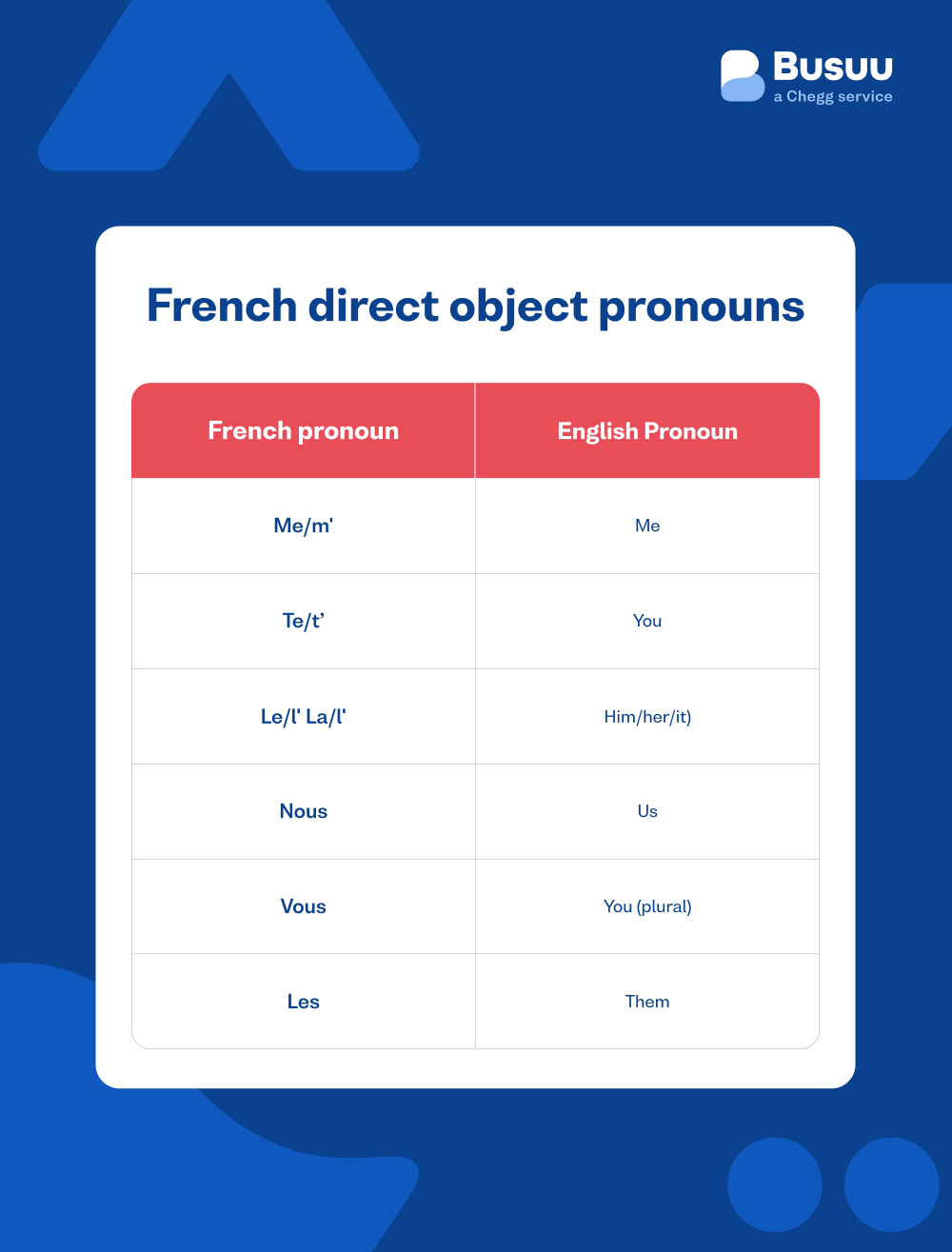
French direct object pronouns table
| French pronoun | English pronoun |
|---|---|
| Me/m' | Me |
| Te/t’ | You |
| Le/l' La/l' | Him/her/it |
| Nous | Us |
| Vous | You (plural) |
| Les | Them |
Indirect object pronouns
If an object in a sentence is receiving the direct object, it’s known as the indirect object in French (and in English too.) You’ll use an indirect object pronoun – or les pronoms compléments d'objet indirect (COI) – if you’re looking to replace it with a pronoun in a sentence.
Here’s an example:
- James lui a donné le ballon. (James gave the ball to him.)
Like with direct object pronouns, you’re probably thinking about the word order of this sentence, and how it differs from an English sentence containing an indirect object pronoun. That’s because in French, indirect object pronouns are placed at the beginning of the sentence, after the subject doing the action.
Here’s a table to help you memorize the different indirect object pronouns.
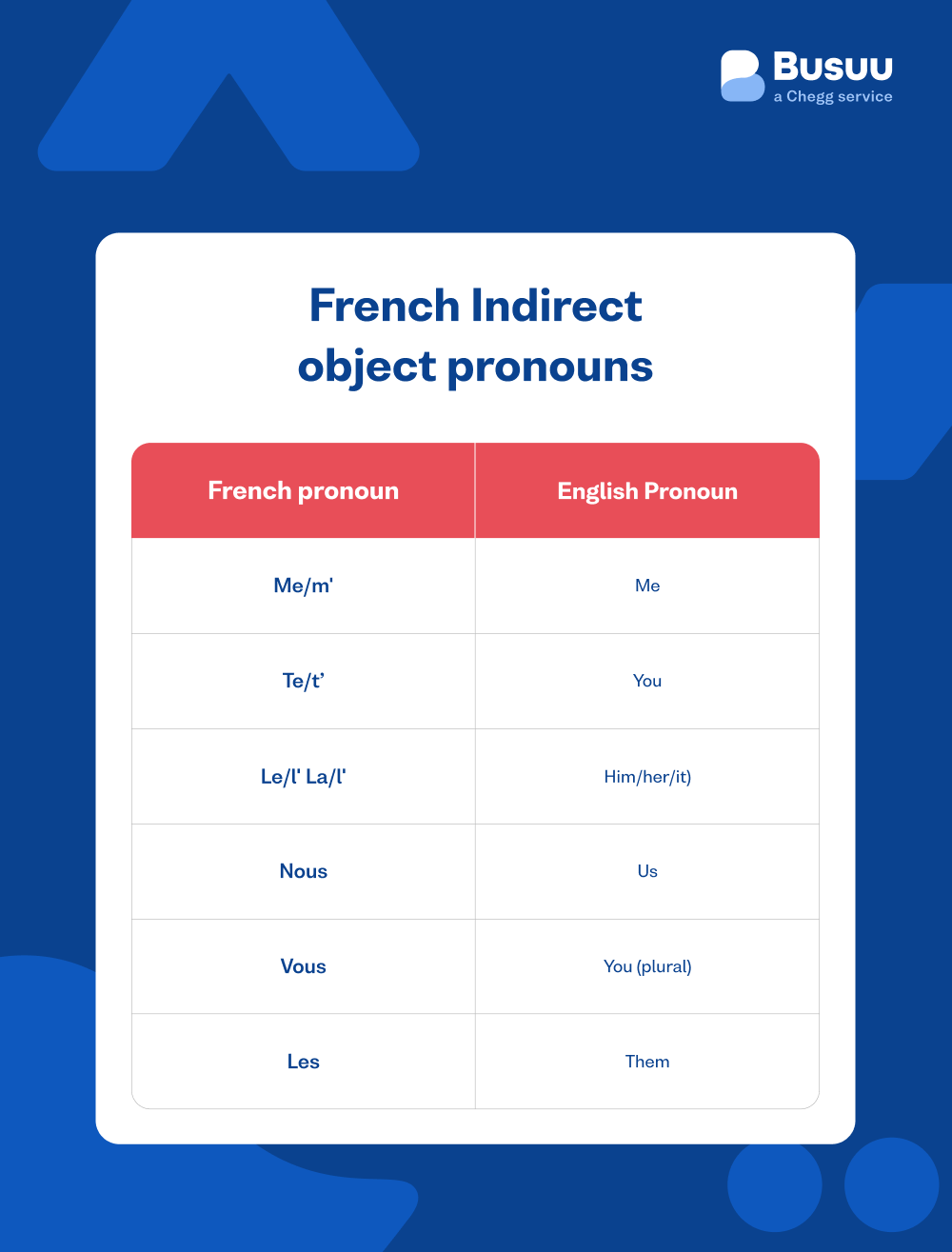
French indirect object pronouns table
| French pronoun | English pronoun |
|---|---|
| Me/m' | Me |
| Te/t’ | You |
| Lui | Him/her/it |
| Nous | Us |
| Vous | You (plural) |
| Leur | Them |
Reflexive pronouns
Like in English, French also uses reflexive pronouns. You’ll be using them alongside reflexive verbs, which you’ll use in a sentence in order to describe a subject acting towards themselves.
For example:
- Je me suis habillée. (I dressed myself.)
In terms of word order, a reflexive pronoun falls between the subject and the verb in the sentence. Here’s a table to help you remember the different reflexive pronouns in French:
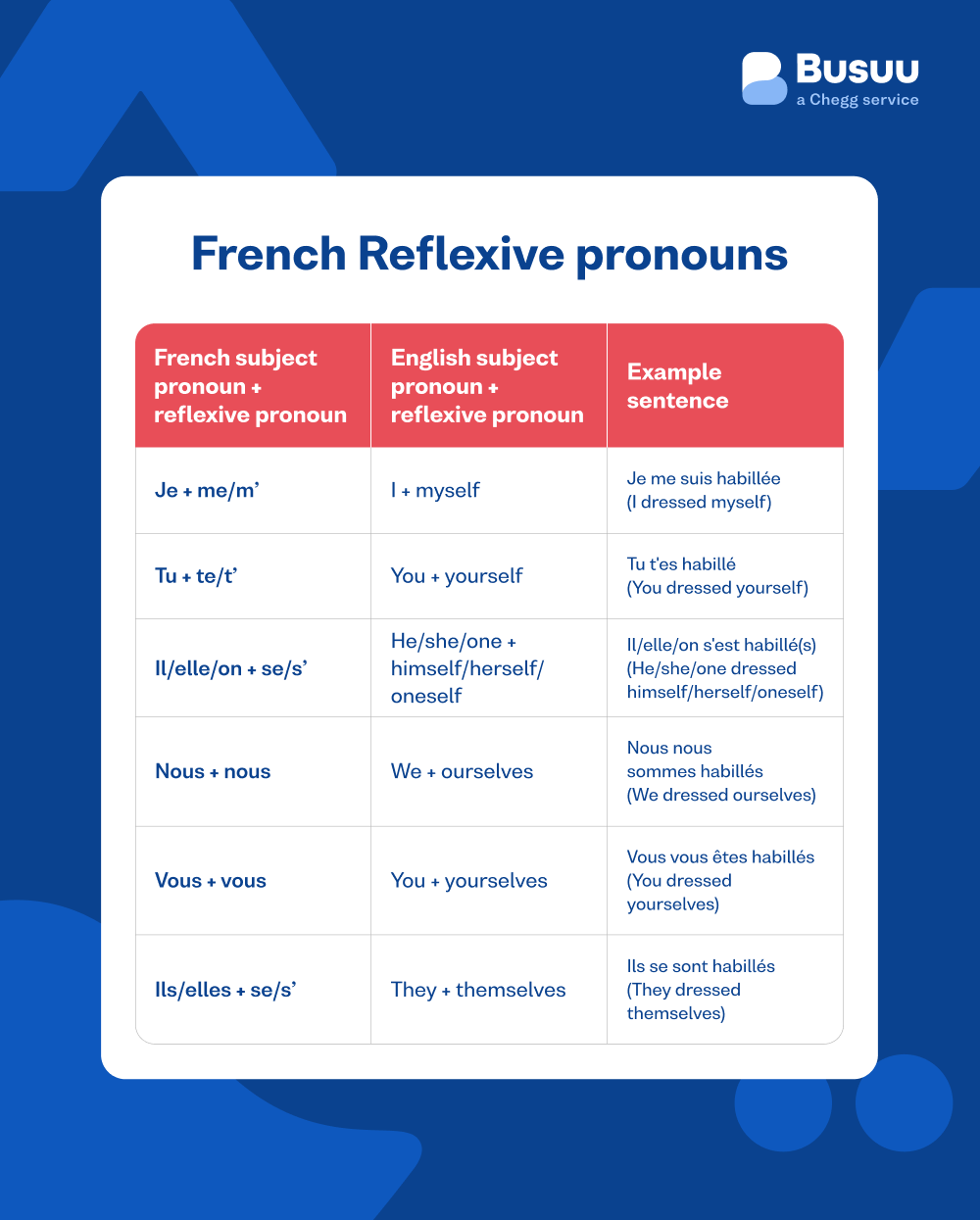
French reflexive pronouns table
| French subject pronoun + reflexive pronoun | English subject pronoun + reflexive pronoun | Example sentence |
|---|---|---|
| Je + me/m’ | I + myself | Je me suis habillée (I dressed myself) |
| Tu + te/t’ | You + yourself | Tu t'es habillé (You dressed yourself) |
| Il/elle/on + se/s’ | He/she/one + himself/herself/oneself | Il/elle/on s'est habillé(s) (He/she/one dressed himself/herself/oneself) |
| Nous + nous | We + ourselves | Nous nous sommes habillés (We dressed ourselves) |
| Vous + vous | You + yourselves | Vous vous êtes habillés (You dressed yourselves) |
| Ils/elles + se/s’ | They + themselves | Ils se sont habillés (They dressed themselves) |
Relative pronouns
Next, let’s move onto relative pronouns. You’ll use these when you want to talk about something you’ve just mentioned in the main sentence clause, and now you want to mention it again in another clause.
The six relative pronouns in French are:
- Qui
- Que
- Lequel
- Où
- Dont
- Quoi
Let’s look at how they work in a sentence. Que replaces the direct object – or subject – in the subordinate clause in a sentence. It usually means “what”. Qui, on the other hand, replaces the subject or indirect object in the subordinate clause in a sentence. It usually means “who”. For a more in-depth look at que vs qui, why not read our guide?
Have you noticed that we use the pronouns qui and que to link two parts of a sentence?
For example:
- J'espère que la région vous plaira. (I hope that you like the area.)
- Je cherche quelqu'un qui aime les animaux. (I am looking for someone who likes animals.)
How to use lequel
Lequel is a little more complex as a relative pronoun than qui and que. It helps to remember that the equivalent in English is usually “which”. You tend to use it for indirect objects (and never subjects), following from prepositions like pour, dans, or de.
For example:
- Le journal dans lequel j'écris un article. (The journal in which I am writing a paper.)
- Le blog pour lequel j'écris. (The blog for which I am writing for.)
You’ll also need to remember that lequel has to agree with the gender of the noun, as well as whether the noun is singular or plural:
- Masculine – lequel
- Feminine – laquelle
- Masculine plural – lesquels
- Feminine plural – lesquelles
If you’re using a preposition like à or de, this will also change the spelling of lequel.
Here’s a quick list so you can remember the different forms:
- à and lequel – auquel
- à and laquelle – à laquelle
- à and lesquels – auxquels
- à and lesquelles – auxquelles
- de and lequel – duquel
- de and laquelle - de laquelle
- de and lesquels – desquels
- de and lesquelles – desquelles
Using où
Now let’s look at où.
Où can be either “where” and “when”. You tend to use this relative pronoun when you need to talk about time and place.
Here are a couple of examples:
- C'est la maison où nous avons grandi. (This is the house where we grew up.)
- C'est l'année où ils se sont rencontrés. (That’s the year they met each other.)
Finally, dont is similar to the English for “whose”, “whom”, or “of which”. You can use it for both people and objects.
For example:
- Le chien, dont le collier était lâche. (The dog, whose collar was loose.)
Quoi or “what”
Finally, let’s look at quoi, or “what”. Wait, but we’ve just covered que which often means “what”.
That’s right, French has another word which generally translates into “what”. However, quoi as a relative pronoun is useful if you want to be able to talk about an unknown antecedent – which means what you’re talking about is unknown (or indefinite).
This might be less abstract sounding once you’ve seen an example:
- Dis-moi ce à quoi tu penses. (Tell me what you think).
In this example, what the other person thinks is an unknown, and so quoi works perfectly fine here.
Interrogative pronouns
As you might have noticed, some interrogative pronouns (pronoms interrogatifs) are the same as relative pronouns – you have qui (who), que (what), lequel (which), and quoi (what). But in this case, they’re used slightly differently. Interrogative pronouns usually come at the beginning of the sentence, and they’re used when you’re asking a question.
Indefinite pronouns
Indefinite pronouns, or les pronoms indéfinis aren’t used in replacement of a noun. They are used to mention things or beings whose identity or quantity is unknown or uncertain. The main indefinite pronouns in French are: aucun, aucune (none), quelque chose (something), quelqu’un (someone), chacun/chacune (each/everyone), and tout (everything).
Possessive pronouns
Les pronoms possessifs or possessive pronouns are used to replace a noun in a sentence which belongs to the subject.
For example:
- Cette voiture ? C'est la mienne. (That car? It’s mine.)
As you can see, the pronom possessif replaces the noun completely in the second sentence, because we already know what the noun is. In French, it’s important to remember that the pronom possessif needs to agree with the gender and number of the noun it’s replacing, rather than the subject which possesses the noun.
To help you remember this, look at the table below:
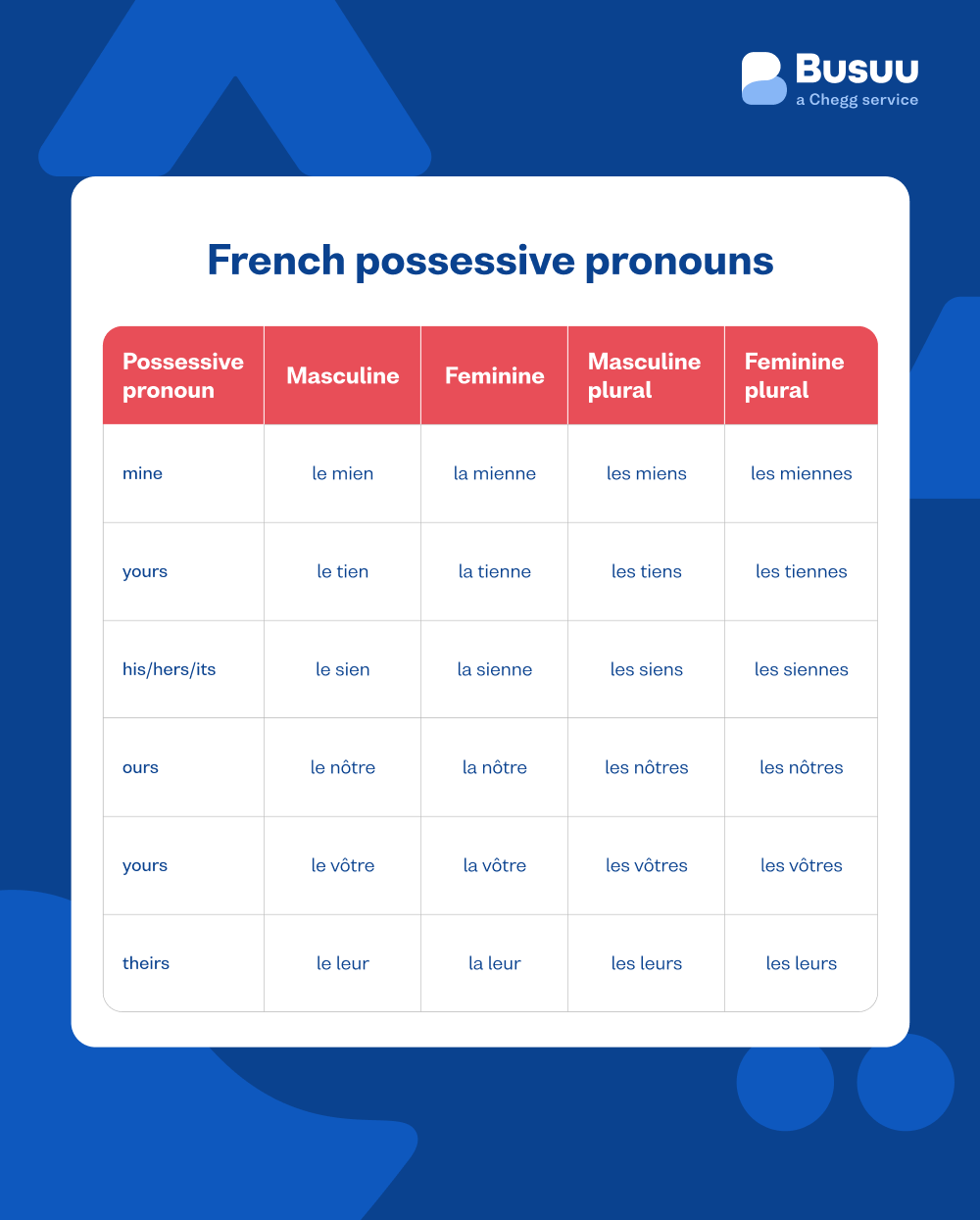
French possessive pronouns table
| Possessive pronoun | Masculine | Feminine | Masculine plural | Feminine plural |
|---|---|---|---|---|
| mine | le mien | la mienne | les miens | les miennes |
| yours | le tien | la tienne | les tiens | les tiennes |
| his/hers/its | le sien | la sienne | les siens | les siennes |
| ours | le nôtre | la nôtre | les nôtres | les nôtres |
| yours | le vôtre | la vôtre | les vôtres | les vôtres |
| theirs | le leur | la leur | les leurs | les leurs |
Demonstrative pronouns
Demonstrative pronouns in French help you to pick out objects in a group.
They are:
- Celui – the one/that one (masc, singular)
- Celle – the one/that one (fem, singular)
- Ceux – these ones/those ones (masc, plural)
- Celles – these ones/those ones (fem, plural)
For example, you’d say:
- Je préfère celui-là. (I like that one better.)
As you can see in this example, celui comes with là. This is a suffix, which tells you how near or far away the object is. If the object is far away, you include là. If the object is close by, you include the suffix ci. They are comparable to “that one” and “this one” in English, respectively.
The adverbial pronoun en
En replaces any noun where there is the preposition de in a sentence. It replaces both de and the noun. It’s usually used in order to replace a quantity, or place.
For example:
- Je n’en ai pas. (I don’t have any.)
The adverbial pronoun y
Y is similar to the English “there”, as it tends to replace a noun in a sentence which has the preposition à or en.
For example:
J'y vois des cailloux. (I see some rocks there.)
While we know that 12 types of French pronouns are a lot to remember, we hope that this guide can be a useful reference point for you in your French learning journey!
By becoming comfortable with French pronouns over time, you can improve your fluency in both speech and writing, making you sound closer to a native speaker.
Want expert help with your French learning?
Busuu offers free online lessons and learning resources designed by experts that can help you supercharge your way to learning French in no time!

